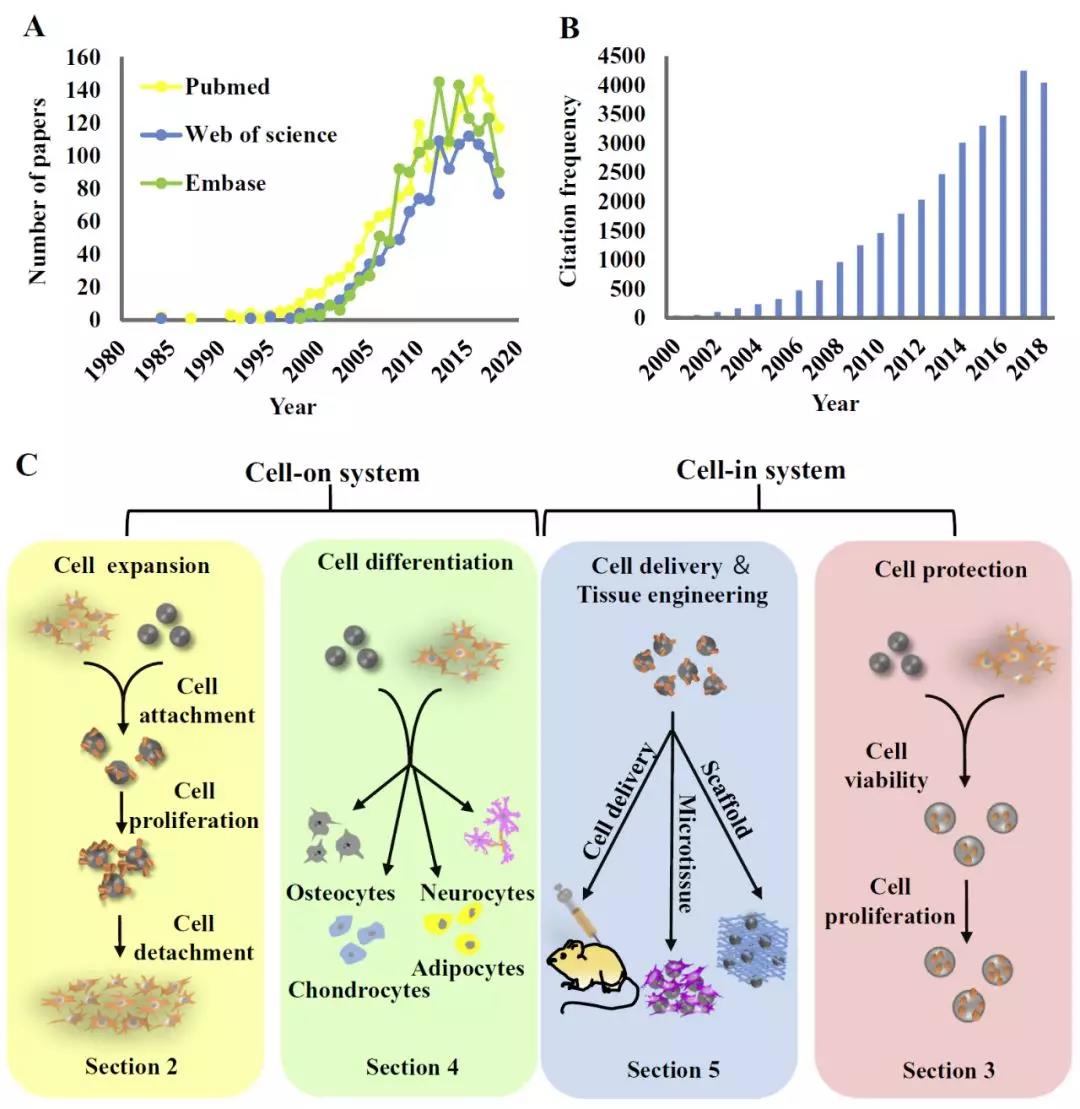Recently, one review paper “Current advances in microsphere based cell culture and tissue engineering” published in Biotechnology Advances (IF=11.452). Prof. Hongwei Ouyang is corresponding author of the paper. Co-first authors are Doctoral candidate Qiulin He (Zhejiang University-University of Edinburgh Institute) and Dr. Jingwei Zhang (Dr. Li Dak Sum & Yip Yio Chin Center for Stem Cells and Regenerative Medicine, Zhejiang University School of Medicine).
Cell-based regenerative therapy has a great prospect in tissue repair. There are many clinical trials and preclinical animal experiments reported cell therapy for complex diseases. Effective cell culture and delivery is a necessary requirement to achieve the clinical applications of cell therapy. Recently, microsphere (MS) based system has attracted and more attention in cell culture and tissue repair (Figure 1A, B). MSs can not only serve as supportive carriers for cell culture, providing different chemical and physical environment for cell growth, but also be excellent delivery carriers for cell therapy in vivo, realizing non-invasive injectable therapy, alleviating the pain of patients, and improving the treatment effect. The main advantages of MSs are: (a) Simple method for large-scale fabrication, which is easy to realize; (b) Uniform and regular porous structure can be formed between MSs; (c) The specific surface area is large, and the size is varied and controllable; (d) MSs are able to control the release of drugs and biomolecules.

Figure 1. (A) Number of papers of “microsphere AND (tissue engineering)” from 1980 to 2018; (B) Citation frequency of papers about “((microsphere) AND tissue engineering)” from 2000 to 2018; (C) Schematic illustrating topics covered in this review.
In this review, MS system has been divided into two categories:(a) Cells cultured on the surface of MSs (cell-on system); and (b) Cells encapsulated in MSs (cell-in system) (Figure 1C). Firstly, in the cell-on system, often used for cell expansion, the final yield depends on cell adhesion ratio, proliferation rate and harvest rate; “low input and high output” should be a criterion for effective cell expansion in vitro. This review summarized three main factors for cell adhesion and proliferation in the cell-on system: chemical property, physical property and surface modification of MSs, as well as three methods for cell detachment: enzymatic treatment, non-enzymatic degradation and temperature-responsive detachment. Secondly, in cell-in system, used to protect encapsulated cells and control cell distribution after in vivo transplantation, is prudent to consider the influential factors so that cells can be supported in high cell viability and proliferation. Factors such as procedures of MS fabrication and architectures of MSs have been introduced in detail. Thirdly, in MS system, stem cells can differentiate into different mature cells, including chondrocytes, osteocytes, adipocytes, neurocytes. Both inherent properties of MSs and biomolecules released from MSs can regulate cell differentiation. At last, cell-loaded MSs provide a revolutionized approach to cell delivery in vivo, in addition to being biomolecule delivery systems, they have the characteristic of being injectableand the capacity to improve cell efficiency. On the one hand, cell-loaded MSs with a specific function serve as small building blocks (microtissues) to be assembled into macroscopic tissues (macrotissues) through a bottom-up approach. On the other hand, MSs can serve as a part of bulk scaffolds to improve biological functions of scaffolds. This review summarized researches about applications of MSs in cell culture and tissue engineering, which provides guidance and reference for future development.
Link of the paper: https://www.sciencedirect.com/science/article/pii/S0734975019301594?from=groupmessage&via%3Dihub=







